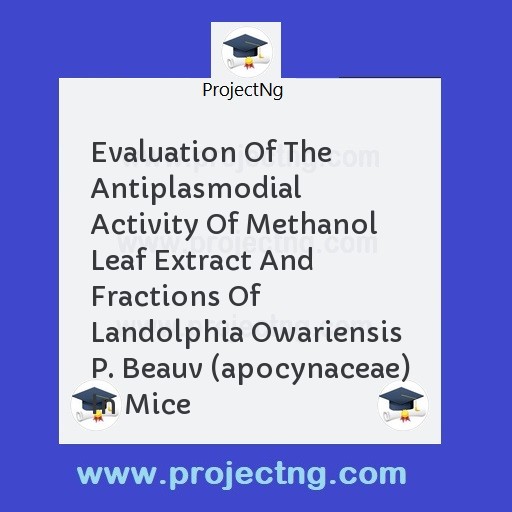Evaluation Of The Antiplasmodial Activity Of Methanol Leaf Extract And Fractions Of Landolphia Owariensis P. Beauv (apocynaceae) In Mice
Pharmacy Project Topics
Get the Complete Project Materials Now! »
EVALUATION OF THE ANTIPLASMODIAL ACTIVITY OF METHANOL LEAF EXTRACT AND FRACTIONS OF LANDOLPHIA OWARIENSIS P. BEAUV (APOCYNACEAE) IN MICE
67
LIST OF TABLES Table 1 List of some plants with antimalarial activity ……………................................. 29
Table 2 Yield (%) of extract and fractions ……………………………………………... 48
Table 3 Phytochemical constituents of extract and fractions ……………………........... 49
Table 4 Acute toxicity testing of methanol leaf extract and fractions of Landolphia owariensis in mice ……………………………………………………………………... 54
Table 5 Effects of methanol extract and fractions of Landolphia owariensis on early infection against Plasmodium berghei berghei infected mice …………………………………………………………………...................................... 56
Table 6 Parasitemia measurement of methanol extract and fractions of Landolphia owariensis on established infection ...……………………….………………………………………………………………... 58
Table 7 Effect of methanol extract and fractions of Landolphia owariensis on established infection against Plasmodium berghei berghei infected mice ……………………………………...…………………………………………………… 59
Table 8 Effects of methanol extract and fractions on prophylactic infection against Plasmodium berghei berghei infected mice …………………………………………………………………………........................... 61
LIST OF FIGURES
Figure 1: Life Cycle of Plasmodium ……………………………………………………. 7
Figure 2: L. owariensis in its natural habitat …………………………………………… 32
Figure 3: HPLC fingerprint profile of methanol extract of L. owariensis …………….………………………………...................................................................... 51
Figure 4: HPLC fingerprint profile of methanol fraction of L. owariensis ………………………………………………………..…………………………………. 52
Figure 5: HPLC fingerprint profile of ethylacetate fraction of L. owariensis ..…………………………………………………………...…………………………….. 53
CHAPTER ONE
1.0 INTRODUCTION
1.1 Background
Malaria presents a global devastating burden. The latest estimates released December 2013 indicate that about 207 million cases of malaria were reported in 2012 with an uncertainty range of 135 million to 287 million and an estimated 627 000 deaths with an uncertainty range of 473 000 to 789 000 (WHO, 2014). A child dies every minute from malaria in Africa. Malaria though a complex disease is preventable and curable (WHO, 2008a; WHO, 2014). It is a disease caused by infection with single-celled protozoan parasites of the genus Plasmodium.
There has been a dramatic increase in both international and domestic funding for malaria control since the last decade as well as an increasing national political commitment to controlling malaria and intensified efforts in endemic countries (WHO, 2008b; Pigott et al., 2012). Malaria control has also featured high on the world’s health and development agenda since the launch of Roll Back Malaria Initiative by World Health Organization (WHO) in 1998. The inspiration behind this initiative was to alleviate poverty and strengthen health systems in malaria endemic countries in such a way that the enormous public health problem caused by malaria will be fundamentally addressed (WHO, 2008b). Despite the intensified efforts and initiative, eradication of malaria still poses a global challenge and threat. Malaria occurs in 109 countries of the world in which Nigeria is one of the 5 main contributors of 50% of global death and 47% of malaria cases. Global strategy consists of three components that will ensure reduction in mortality and morbidity of malaria. This includes control with
existing tools, elimination by complete interruption of malaria transmission and continued research to create new tools and approaches (WHO, 2008a).
1.2 Definition of Malaria Malaria has variety of meanings but can be defined in general terms as a parasitic disease, illness, infection or a public health problem caused by protozoa of the genus Plasmodium which afflicts an individual or a community (Koram and Molyneux, 2007). Malaria is an acute parasitic disease due to Plasmodium spp infection of the red blood cells leading to constellation of signs and symptoms such as cyclical fever, muscle pains, headache, vomiting, diarrhoea, cough etc. which if untreated can rapidly lead to complications and death.
1.3 Epidemiology of Malaria
The distribution and intensity of malaria is geographically specific. Even though malaria is prevalent in poor countries, its severity and difficulty in controlling it is primarily determined by climate and ecology. Other determinants include the general level of urbanization like inadequate sewage disposal and treatment, poor hygiene practices, lack of safe drinking water and substandard housing conditions which are all direct consequences of poverty. Personal behavior such as inability to carry out outdoor spraying or use insecticide treated nets also contribute to the poor difficulty in controlling malaria (Gallup and Sachs, 2001).
Epidemiology of malaria is driven by the goal of malaria control and elimination which is to reduce morbidity and mortality of malaria as well as interrupt the chain of local transmission. Therefore, understanding the dynamics of malarial transmission and vectorial capacity is fundamental to achieving this goal (Gallup and Sachs, 2001; WHO, 2008b).
In Sub Saharan African countries where data collection systems are often rudimentary, accurate statistics due to malaria deaths are rarely available and childhood fever or other illnesses are majorly attributed to malaria, (Iley, 2006). Despite the high mortality rates, existing vital registration systems are not reliable or comprehensive and most deaths occur outside the health facilities (Snow and Omumbo, 2006). Invariably, there is lack of precision in current malaria statistics (Snow et al., 2005; Bell et al., 2005). This presents an interesting epidemiological challenge to sub Saharan Africa. Sequel to this is the documented evidences on overdiagnosis and misdiagnosis of malaria where malaria cases are reported and treated despite laboratory confirmation of no parastemia (Reyburn et al., 2004; Gwer et al., 2007; Nankabirwa et al., 2009; Leslie et al., 2012; Oladosu and Oyibo, 2013).
In Nigeria however, malaria constitutes an economic burden with an annual economic loss of about 132 billion Naira as, cost of treatment, prevention, loss of man-hour among others per annuum and also accounts for 60% outpatient visits as well as 30% hospital admissions.
1.4 Etiology of Malaria
Be the First to Share On Social

Enjoying our content?
Don't miss out on new videos! Subscribe to our YouTube channel for more awesome content.
Subscribe Now!













